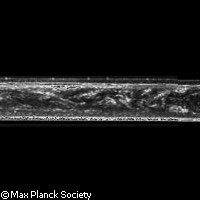Nov 26 2008
Scientists in Germany and the Netherlands have shown that, contrary to popular belief, the state of turbulence seen in liquids and gases when they flow at high speeds is not permanent. The study demonstrates with unprecedented precision that in pipe flows, turbulence disappears with time. The results are published in the journal Physical Review Letters

In fluid dynamics, turbulence describes a state of chaotic, random changes. Non-turbulent or smooth flow is called 'laminar' flow. As speed increases, a transition is made at some point from laminar to turbulent flow. This transition is to some extent governed by the inner forces of the molecules involved: when the forces of acceleration are greater than the inner forces that hold molecules together, unsteady vortices appear, eddies are formed and drag fluctuates. Speed is a major factor in turbulence, but object size and viscosity also play a major role.
Scientists until now have assumed that once turbulence is achieved, it will remain constant so long as the velocity is maintained. However, a study led by Dr Björn Hof of the Max Planck Institute in Germany has found evidence to the contrary.
Turbulence reduces energy efficiency in equipment such as ducts, pipes and gas turbines. Accordingly, the reduction of turbulence is an area of intense study. 'Turbulent flow consumes more energy than laminar flow,' said Dr Hof. 'In many applications such as oil pipelines they are therefore bothersome.'
The team created eddies in water flowing through 1-metre-long glass pipes of varying widths, using a constant pressure head. A constant resistance was added to avoid fluctuations due to drag, and temperature was kept strictly constant to avoid changes in viscosity. They then followed the movement of 'turbulence puffs' down the pipe and calculated the probability that the puff would arrive at the exit, or smooth out. The velocity of the puffs was measured using laser Doppler anenometry. The researchers were then able to interpret the 'decay rate' of turbulence with unprecedented accuracy.
'In order to discern whether turbulence is stable or only has an extremely long lifetime, our measurements had to be very exact,' explained Dr Hof. 'Our measurements show that every turbulent flow in a pipe will inevitably become laminar.' The transition is by no means swift - depending on the geometry of the pipe, it may take years - but it is in fact inevitable.
A complete, exact description of turbulence is one of the outstanding challenges in the physical sciences. The current study represents an advance in this area, although it does not address the nature of turbulence outside of pipes. Building on their new knowledge, the scientists believe that it may be possible to shorten the duration of turbulence within pipes, which could result in significant energy savings.